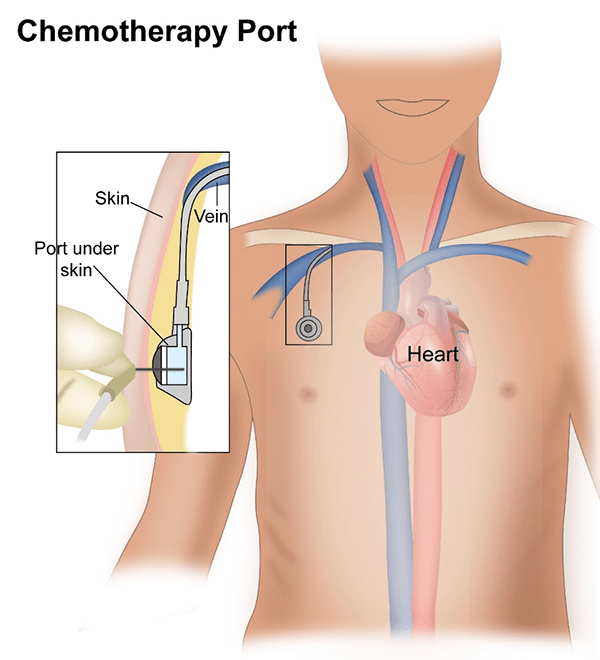Chemotherapy Lines
Normally, Chemotherapy is given into a vein on the back of the hand or on the forearm. In situations, where the access to the veins is difficult or when the course of chemotherapy is prolonged or when continuous infusion of Chemotherapy is needed, a central line is inserted to make it easy to give the treatment. There are different types of lines that can be used, and these are briefly described below.
PICC Line
A PICC (peripherally inserted central line) line is a long and narrow tube that is inserted into a vein in the arm. The tip of the line is present in the big veins of the chest above the heart (SVC). The other end is outside the body and can be used to administer medications and take blood samples.
The line is inserted by an interventional radiologist or vascular surgeon or a specially trained nurse. A local anaesthetic is used to help insert the line without any pain.
A PICC line can be left in place for as long as needed for the treatment. The line should be flushed once a week even if not in use.
The following complications can happen as a result of a PICC line and it is important to see your doctor about them.
- Bleeding
- Redness and pain around the line site
- PICC line has come out partially or fully or is loose and hanging
- Feeling unwell or have a fever
Hickman or Groshong Tunnelled Line
This is another type of central line where one end is in the large vein of the chest above the heart (SVC) and the other end hangs out from the skin of the upper chest. There is a small segment of the line that is tunnelled under the skin between the two ends.
This line is inserted by a Radiologist, Surgical Oncologist or a Vascular surgeon.
This line can be left in place for as long as needed and has to be flushed at least once a week. Complications for this line include
- Infection at the line site
- Infection in the Vein
- Line that has come out or broke
- Clot formation around the line.

Chemo Port

A chemo port is also a central vein inserted into the large vein in the chest above the heart. The difference between a chemo port and other lines are that the other end of the line does not hang out through the skin. Instead, the end has a port which is round and is placed under the skin. It cannot be seen from outside but can be felt when a hand is placed over the upper chest. The port has a area where a needle can be inserted into to take blood or to give Chemotherapy. This port is inserted into the patient by a Surgical Oncologist or Vascular surgeon.
As both ends of the port are inside the patient, the risk of infection is less with this type of line. However, complications can still happen and include
- Infection
- Clot formation in the vein
- Breaking or snapping of the line




